Your traffic has been flat or declining, despite trying longer articles, using more keywords, and optimizing meta descriptions.
Meanwhile, AI Overviews are stealing clicks. Reddit threads outrank your posts, and ChatGPT answers queries without sending visitors to your site.
Over 58.5% of searches now end without a click, and CTRs for AI Overview queries have fallen from 1.76% to 0.61%. Almost half of marketers have already shifted their SEO strategy.
The old SEO playbook is dead. However, some sites are thriving, experiencing higher engagement, stronger conversions, and increased revenue from fewer, more targeted visitors.
After analyzing hundreds of sites, watching experts on Reddit and LinkedIn, and testing strategies myself, the pattern is clear: the sites winning now aren’t doing more, they’re doing different.
In this article, I’ll show you exactly how to increase your organic traffic in 2025. You shouldn’t expect old or generic strategies.
Let’s get started.
Table Of Contents
- Create a People-first content with E-E-A-T focus
- Perform SERP Gap Analysis for Intent-Driven Content
- Build Topical Authority Through Content Clusters
- Prune and Consolidate Low-Value Content
- Establish a Content Refresh Schedule
- Optimize for Attention Metrics and User Engagement
- Enhance Technical SEO and Core Web Vitals
- Implement Structured Data and Entity Signals
- Optimize for AI Overviews, Zero-Click, and Answer Engines
- Target Long-Tail and High-Intent Keywords
- Master Internal Linking for Authority Flow
- Leverage User-Generated and Community-Driven Content
- Build High-Quality Backlinks and Brand Signals
- Dominate Local Search (For Service Businesses)
- Leverage High-DA Platforms for Quick Wins
- Create Funnel-Driven Content That Converts
- Create Video-First Content and Repurpose Across Platforms
- Build Brand Presence Across Channels
- Use Programmatic SEO to Scale Smartly
- Track Metrics That Actually Matter and Adapt
1 Create a People-First Content with E-E-A-T Focus
You know those old tips about writing helpful content for your audience, creating longer articles, and choosing keywords based on search volume alone? Those Google SEO strategies are outdated now.
What actually increases organic traffic is creating content for a specific, clearly defined person.
Instead of writing for “everyone,” you target a specific group of people and solve their exact problems. And for you to do this successfully, you must research your audience and understand their search intent.

Whatever you’re writing, say it like you’re helping a specific person face-to-face. One of the best ways to determine if you’re on track is to run a people-first content audit on your site.
Go through your top 20 blog posts. For each, ask: “Does this page directly help a real person accomplish a task, answer a specific question, or make a decision?” If not, update or remove it.
Google wants proof that you actually did what you write about, not just researched online. That’s why E-E-A-T (Experience, Expertise, Authoritativeness, Trustworthiness) became crucial for organic search rankings. Here are a few steps to implement it:
- Add at least one original visual to every article: a custom screenshot, a photo you took, a Loom video, or an original chart.
- Use first-person language, such as “In our testing…” or “We found that…” or “Based on our experience with clients…”
- Include an author byline with credentials and link to their LinkedIn profile.
- Share real metrics from your own results, your scars, what didn’t work, not just what did.
- Include video testimonials or user-generated content where possible.
The point here? Know the friend you’re talking to and help them. Google rewards originality, depth, and human insights, not just AI-generated content flooding the internet.
Want to try something awesome? Convert your top-10 ranking page into a 1,200 to 1,800-word case study that includes a real metric like “we increased X by Y%” and resubmit your sitemap. This will actually help increase your organic traffic.
2 Perform SERP Gap Analysis for Intent-Driven Content
You’ve got to do this before creating any content at all if you actually want to increase the organic traffic of your website: perform a SERP gap analysis.
If you’re still just finding “high volume, low competition” keywords and writing content, you’re competing with one hand tied behind your back.
Here’s what changed. You’re not just competing against other websites anymore. You’re competing against Google’s AI Overviews that answer questions without sending clicks. You’re competing against Featured Snippets. You’re competing against Reddit threads and TikTok videos showing up in results.
So before you write a single word, you need to play detective.
- Type your target keyword into Google and conduct a detailed breakdown of the top 5 to 10 results.
- Note the format: listicles, step-by-step guides, video carousels, product pages.
- Identify the dominant angle: are they “for beginners,” “cheap options,” “reviews”?
- Find what’s missing. If all top results are text-based, create a video guide. If they’re all superficial, create a deep, step-by-step walkthrough.
Also, ensure the contents match user intent because that’s exactly what Google is serving people today.
For informational queries, write educational content with clear steps, such as “how to fix X.” For commercial intent, create comparison tables, expert reviews, and data-driven analysis, like “best X for Y.”
For transactional queries, create product pages with clear CTAs, pricing, and availability information. For a navigational query, create head-to-head comparisons with definitive conclusions like “X brand vs Y brand.”
You can also use Google’s “People also ask” and “People also search for” to identify subtopics that the current top results are missing.
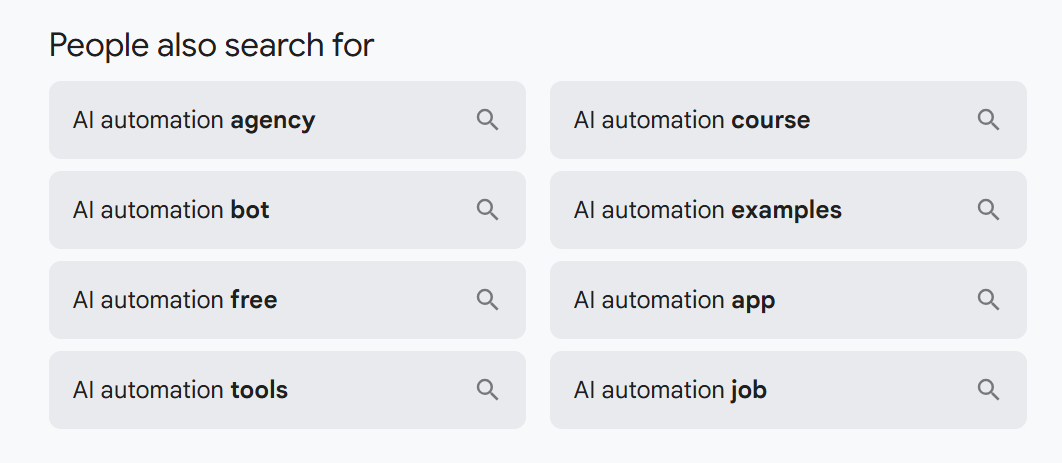
While writing, don’t just rewrite what’s already out there. Bring more to the table. Don’t just target keywords; solve the user’s search intent better than anyone else.
3 Build Topical Authority Through Content Clusters
Scattering blog posts across random topics no longer works. Google doesn’t rank individual pages in isolation; it ranks entire sites as authorities on specific topics.
Think about it. When you search for keto diet advice, you don’t just want one article. You want to land on a site that clearly knows everything about the keto diet. That’s what topical authority is.
So here’s what you do instead of just “publishing more blog posts.”
- Choose one core topic you want to dominate, like “Local SEO for Restaurants.”
- Create one massive pillar page, 2,500 to 4,000 words, covering the topic comprehensively.
- Create 15 to 30 cluster articles covering every subtopic, question, and angle in depth.
- Interlink all cluster posts to the pillar page with descriptive anchor text.
- Add “related content” sections to keep users flowing through your content.
- Update your pillar page quarterly with fresh data.
Rank Math SEO can absolutely make this easier for you. It helps you mark your page as pillar content, making it easy to interlink all your cluster content to it.
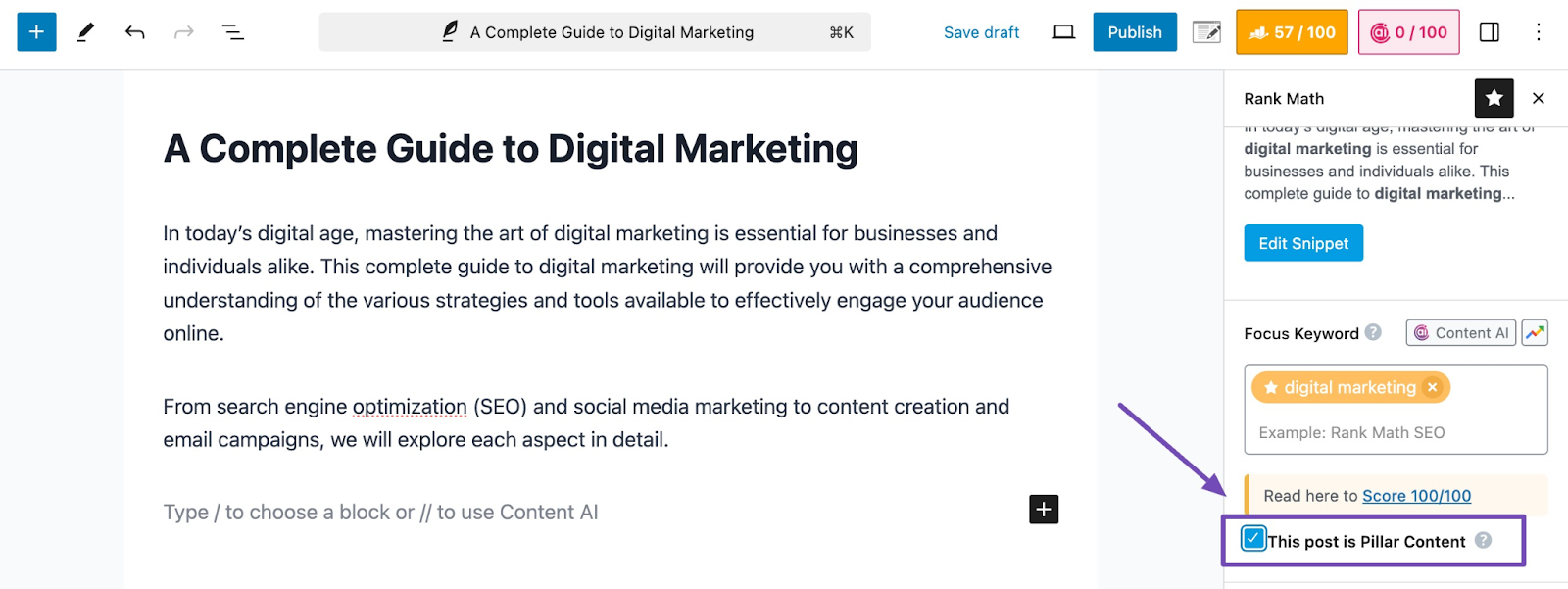
Its Content AI’s RankBot can also help you generate different cluster content ideas, which you can use to expedite your keyword research. Just navigate to Rank Math SEO → Content AI → Chat from your WordPress dashboard.
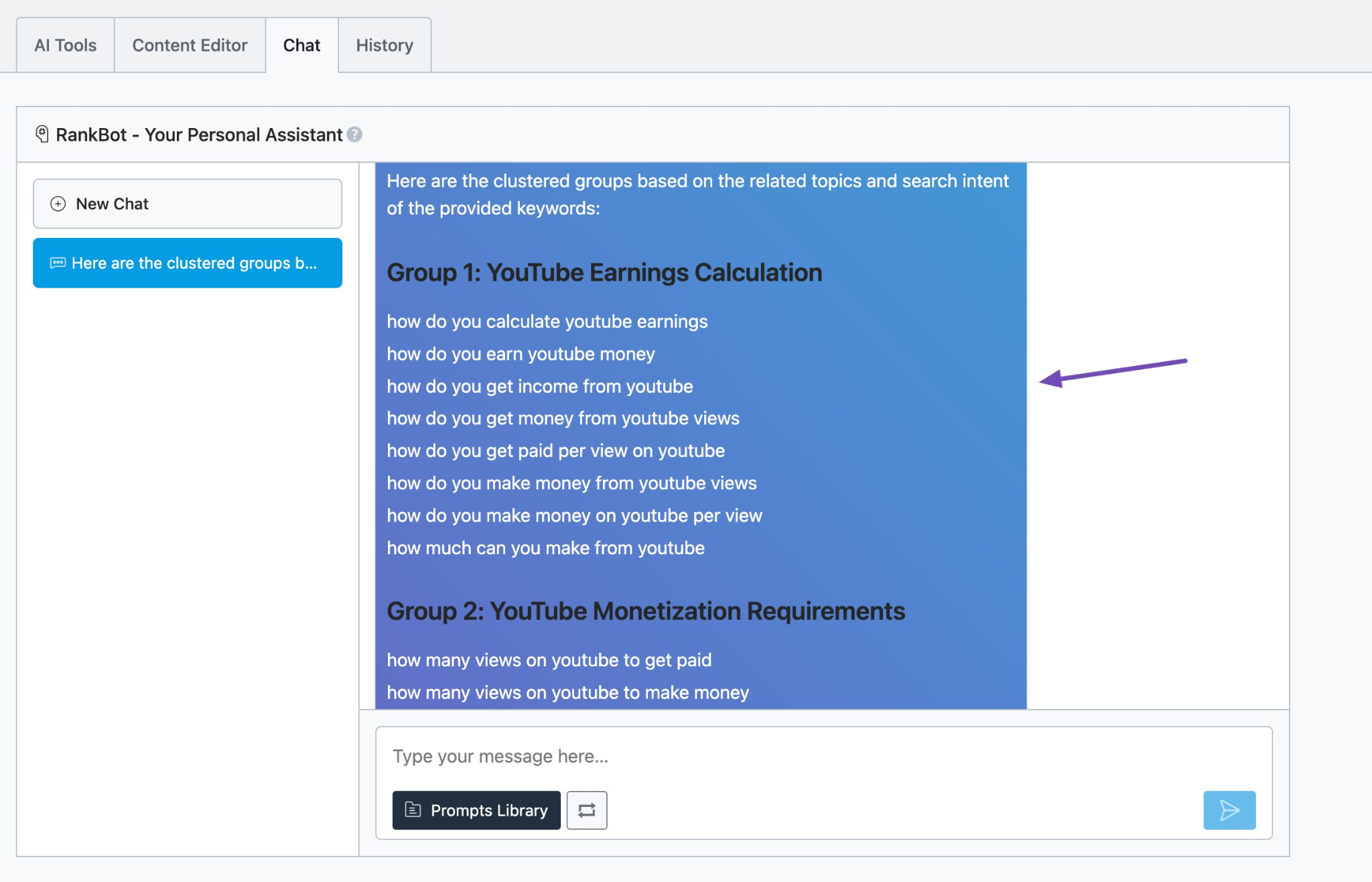
If you create great topical authority through cluster content, you’re telling Google you’re the best and an expert in your field. Users will find the best user experience, and you will create powerful internal link equity.
For more details on how to establish proper topical authority, refer to our guide here.
4 Prune and Consolidate Low-Value Content
If your site’s been around for a while, you’re probably carrying dead weight. Old posts that get zero traffic. Thin articles that don’t help anyone. Duplicate content targeting the same keywords.
Here’s the truth. This low-value content is actively hurting you. It dilutes your site’s authority. It wastes Google’s crawl budget. It makes your good content harder to find.
I know what you’re thinking. “But what if those posts bring in some long-tail traffic eventually?” Listen, if a page has received fewer visits in the past month, it’s not suddenly going to take off. Cut it loose.
Here’s what actually qualifies as low-value content.
- Pages with under 100 visits in 12 months.
- Pages under 400 words with thin or duplicate text.
- Anything with outdated information, pre-2023 stats, old screenshots, or dead advice.
- Multiple articles all targeting the same keyword.
- Pages with zero backlinks, zero engagement, zero conversions.
- Orphaned pages that nothing else even links to.
Here’s your action plan. Open Google Search Console → Performance right now. Filter for pages with fewer than 10 clicks in the past 6 months. For each one, make a decision.
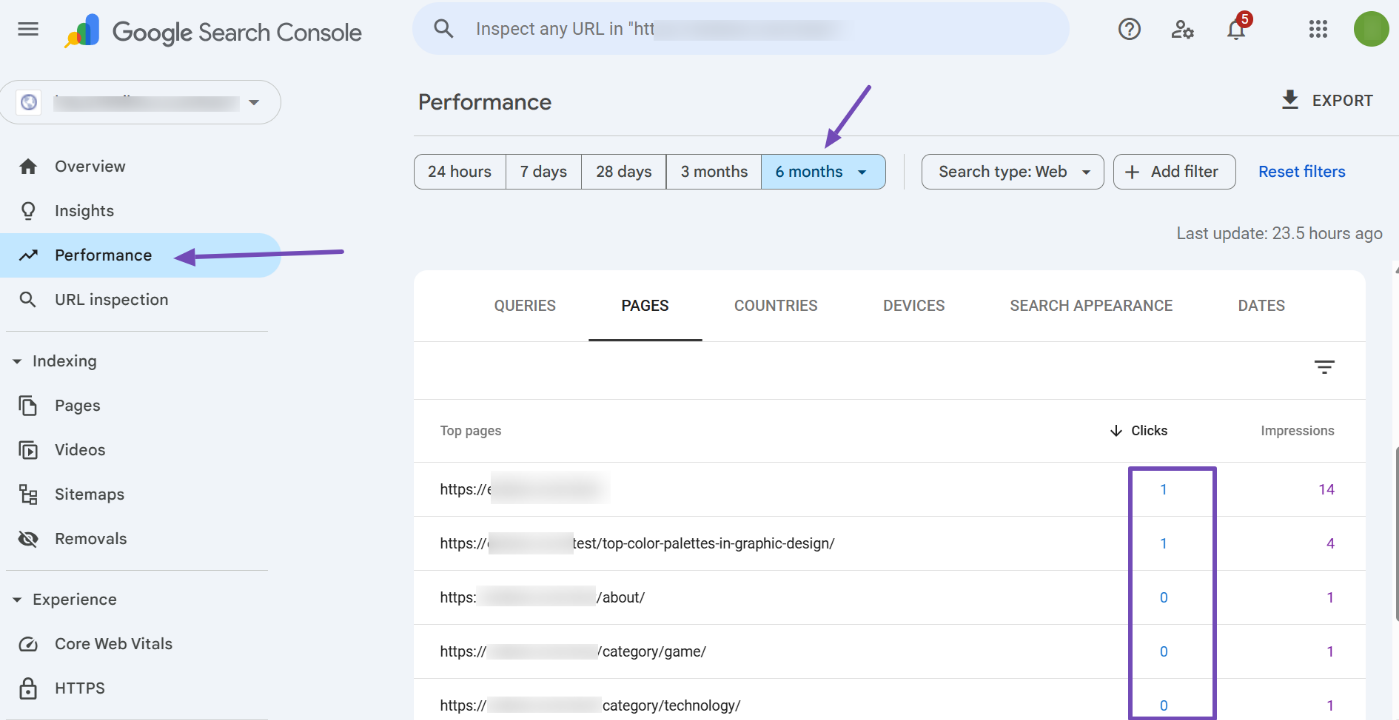
Delete it (use 410 status) if it’s completely irrelevant or outdated. Merge it (301 redirect) into a stronger, related article if the topic is still relevant. Update it aggressively if the topic matters, but the execution is weak.
This is not about having fewer pages. It’s about ensuring every page on your site earns its place. Quality over quantity isn’t just a cliché; it’s how Google actually works now.
5 Establish a Content Refresh Schedule
Backlinko conducted a test in which they updated one of their old articles with fresh statistics and examples. Traffic increased by 70% in just a few months. Not from a new post. From updating an existing one.
In fact, recent research we conducted on ChatGPT SEO revealed that ChatGPT primarily recommends answers from the most recent months of the year.

The truth is that every piece of content has its expiration date. You need to update your content through regular content refreshes. If not, the recent or fresher ones are going to outrank them.
Sometimes you may think your evergreen content lasts forever, or you refuse to touch your content because it’s ranking well. Don’t fall into that trap.
So here’s what to do instead:
- Audit quarterly using Search Console or Google Analytics to identify pages that are losing clicks or impressions.
- Refresh only what matters, focus on your top 20 to 30% of pages that drive most traffic or conversions.
- Add real value. Update statistics to 2024/2025. Add new screenshots. Include recent examples or case studies. Expand sections that are too thin.
- Update your titles and dates. Change “2022 Guide” to “2025 Guide.” Make it obvious that the content is current.
- Track your updates in a simple spreadsheet. Note the last refresh date for each critical page to ensure consistency.
Avoid “fake edits.” Don’t just change the date and call it updated. Google can tell. Only refresh when you’re genuinely improving the quality or accuracy.
Over time, refreshed pages regain rankings faster than new content can earn them. The sites winning right now aren’t publishing the most; they’re maintaining the best.
6 Optimize for Attention Metrics and User Engagement
Let’s be honest for a second. Google isn’t just counting clicks anymore. They’re measuring satisfaction.
Google knows exactly what people do after clicking on your result. If visitors immediately bounce back to search results, you’re basically telling Google, “my content didn’t help.”
Those high bounce rates and short dwell times? They’re actively damaging your rankings right now.
I see too many site owners obsessing over getting the click, then wondering why their traffic stalls. The old advice that “bounce rate doesn’t matter” is dead wrong in 2025.
Here’s what Google actually measures now. Dwell time, how long before they bounce back to search. Scroll depth, how far they actually read. Interaction rates, whether they click anything or just skim.
The goal is simple. Transform your content from static text into something that genuinely engages people.
Now here’s what to do.
- Add a sticky table of contents to long guides. This keeps readers navigating instead of getting lost. When they can jump to the exact section they need, they stay longer and explore more.
- Embed a relevant video midway through your article. A 2-minute tutorial or explanation can dramatically increase time on page. People who watch even 30 seconds are sending strong engagement signals.
- Include one interactive element. A quick quiz. A simple ROI calculator. A before/after slider. Interaction is one of the most powerful satisfaction signals you can send.
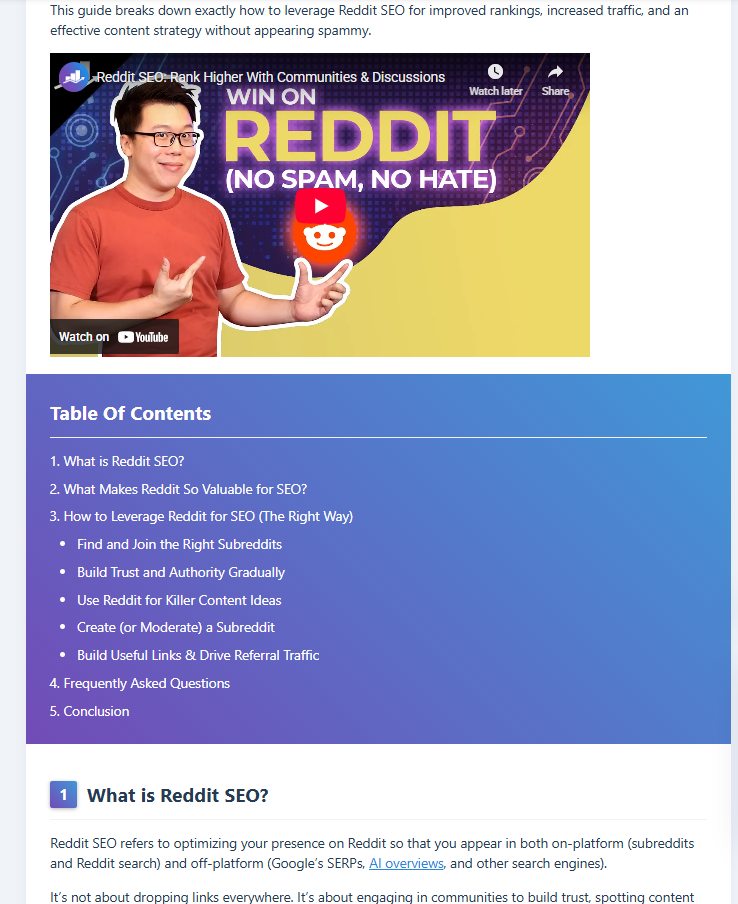
Here’s the thing. If your content only provides quick answers, AI summaries will likely replace it entirely.
You need to go deeper. Provide insights that can’t fit in a snippet. Offer something users actually want to explore, not just skim.
Every extra second a visitor stays is a signal of trust and value. Optimize for engagement, and you’ll naturally start ranking higher.
7 Enhance Technical SEO and Core Web Vitals
Here’s a hard truth: even the best content will fail if your technical foundation is weak. Google can’t rank what it can’t properly crawl, index, or understand.
I frequently see brilliant articles held back by basic, fixable errors that signal to Google that your site isn’t reliable.
Your first move is to go to Google Search Console → Pages. There, you can find reasons that might be preventing your site from being indexed by Google, such as duplicate pages, noindexed pages, etc.
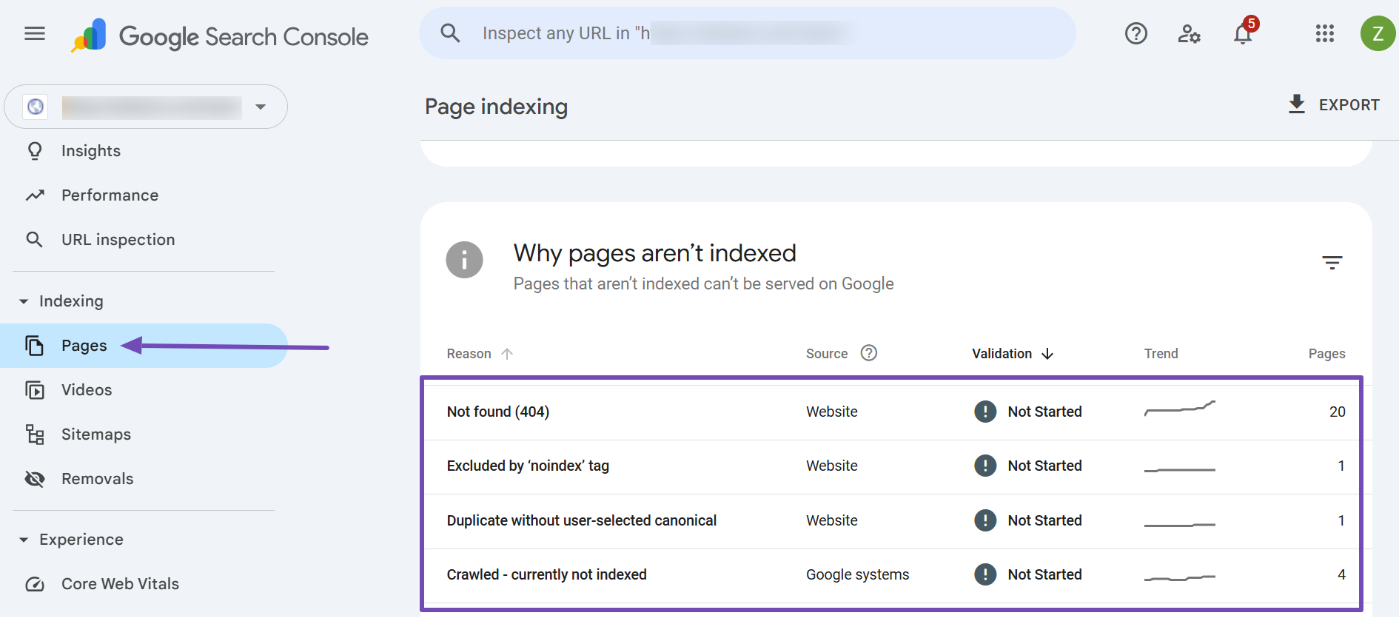
You can also use Rank Math to find the broken links and orphaned pages on your site. Identify these errors, take your time, and fix them.
Also, prioritize Core Web Vitals, specifically Largest Contentful Paint (how fast your main content loads) and Interaction to Next Paint (how quickly the page responds to clicks).
You can simply do this by compressing your images to next-gen formats like WebP or AVIF automatically using a plugin like Imagify.
You can also install WP Rocket on your site to help you defer unnecessary JavaScript and preload critical assets. Then implement caching and a CDN on your WordPress site.
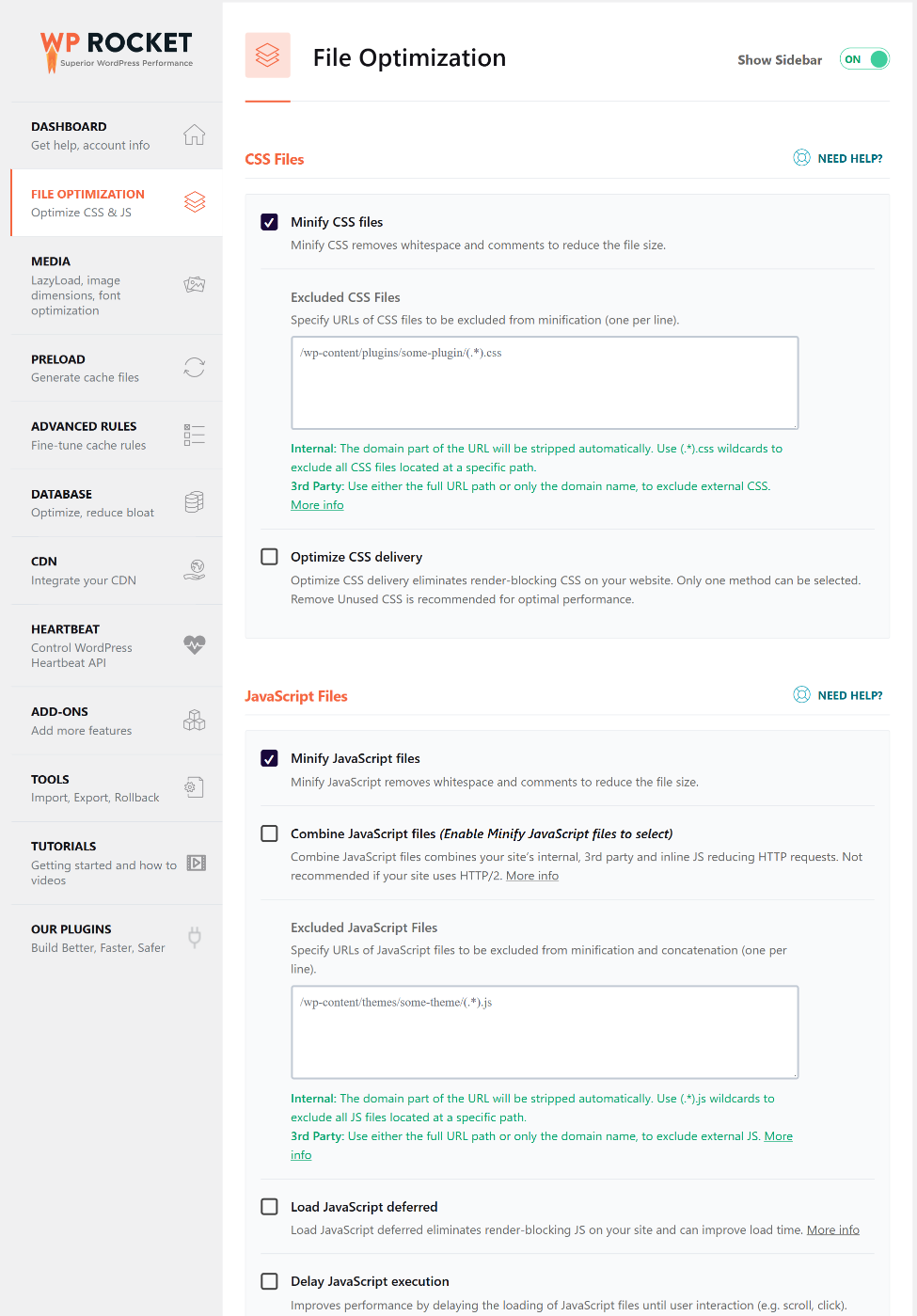
And please, test on mobile. Over 60% of traffic is mobile now. If your site isn’t flawless on a phone, you’re actively losing rankings and customers right now.
For a comprehensive guide on website speed optimization, refer to our detailed walkthrough here.
8 Implement Structured Data and Entity Signals
Search engines and AI systems are attempting to understand your content in a manner similar to how humans would. However, they’re not human, so you need to assist them.
That’s where structured data comes in. It’s basically you telling Google, “hey, this is an article about X, written by Y, published on Z date, and here are the key facts.”
Start with the basics. Add Schema markup to your main content types. Use Article schema for blog posts. FAQ schema for Q&A content. HowTo schema for step-by-step guides. Product schema for reviews or comparisons.
You can do this easily with Rank Math SEO. Open your post, navigate to the Rank Math SEO meta box to the Schema tab, choose the schema type, and fill in the details. Rank Math will automatically generate valid schema markup for you.
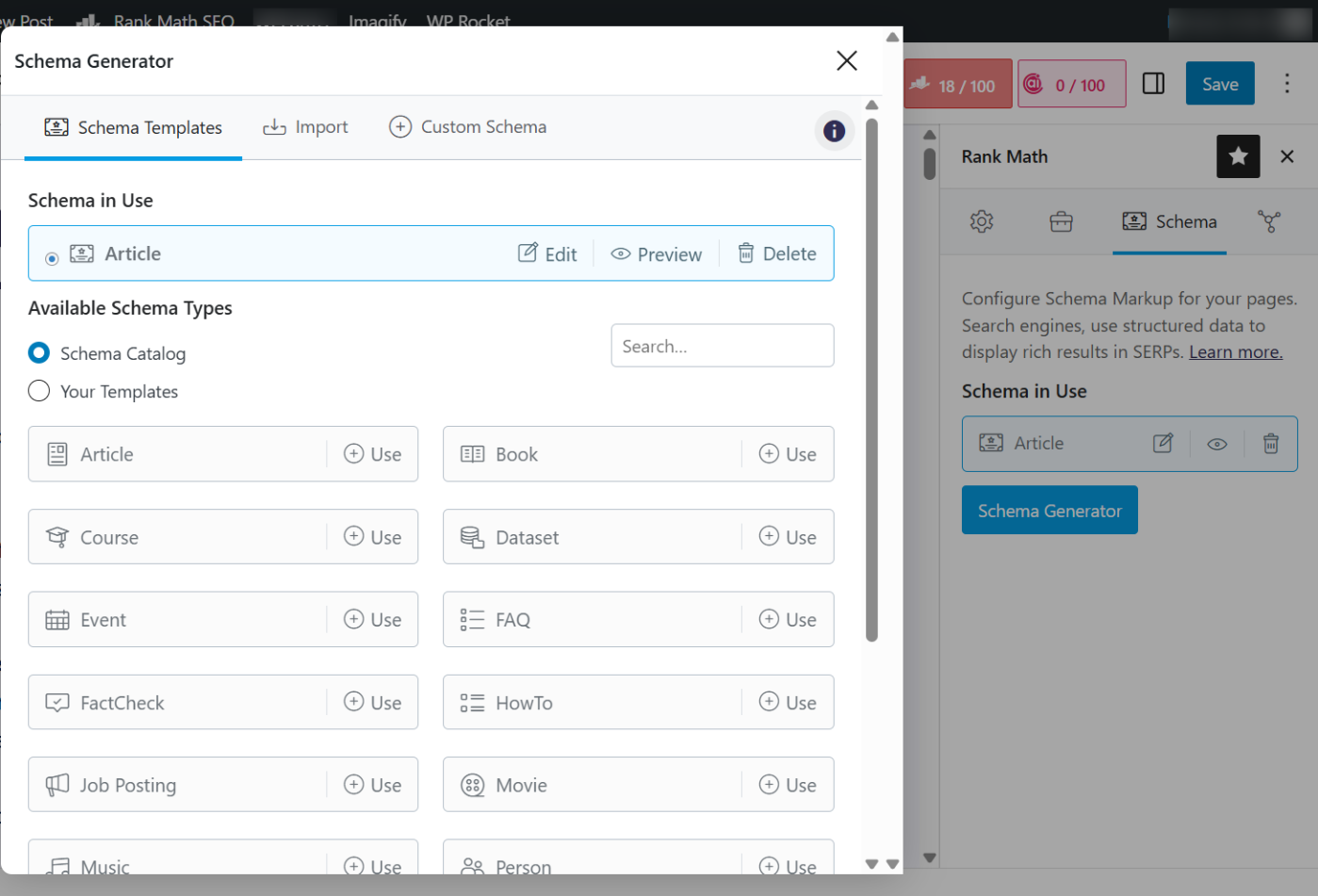
To make your pages more understandable:
- Use clear H1 and H2 headings that reflect what’s in each section
- Add bullet lists and short data blocks with key facts or metrics
- Mention relevant entities such as people, brands, tools, or locations
- Write in natural, structured language so AI and Google can easily read the context
Structured data is one of the simplest ways to boost visibility without creating new content. It helps you stand out in search results with rich snippets, star ratings, or FAQ dropdowns, which attract more clicks.
9 Optimize for AI Overviews, Zero-Click, and Answer Engines
AI results now dominate search. Google AI Overviews, ChatGPT, and Perplexity are all pulling direct answers from content across the web. Your goal is to be the source they cite.
AI Overviews now appear on 13% of searches, doubled in just two months. ChatGPT processes over 1 billion queries daily.
They just give the answer right there. But here’s what nobody talks about: visitors who DO click through from AI sources convert 4.4 times better than regular organic traffic.
Here’s how to get AI to cite you:
- Add a TL;DR box at the top of every article. Give 3 to 5 bullet points with direct answers. AI systems love pulling these clean summaries.
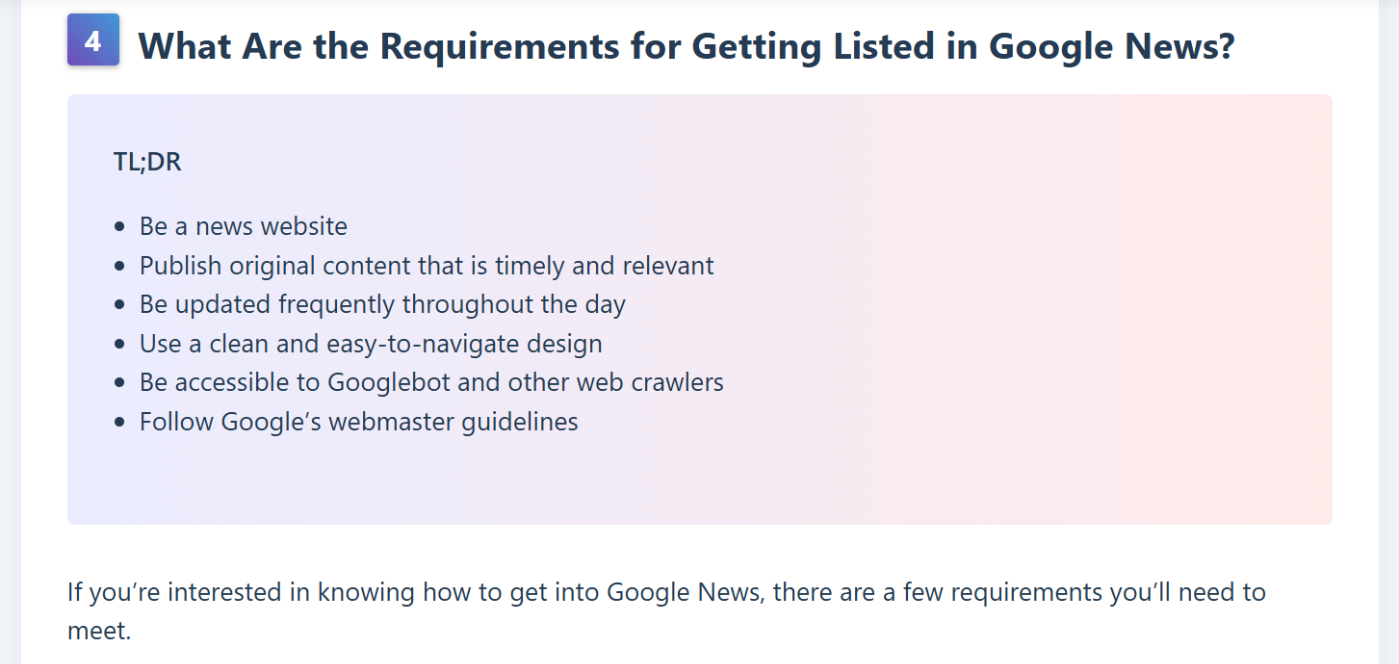
- Use question-based headings. Instead of “Performance Tips,” write “How Do You Improve Page Speed in WordPress?”
- Give complete answers upfront. Don’t build suspense. Just answer the question clearly in the first paragraph, then go deeper after.
- Include specific stats and sources. AI systems prioritize content that cites data.
- Keep content fresh. AI systems heavily favor recent content. Even for evergreen topics, they prefer answers from the last few months over older content.
Now here’s the key differentiator. Add elements AI can’t replicate. Downloadable checklists. Custom tools. Interactive calculators. Original templates. These give people a reason to click through even when AI has already shown the summary.
For comprehensive guides on ranking in these specific systems, refer to our ChatGPT visibility guide and Google AI Overviews optimization guide.
10 Target Long-Tail and High-Intent Keywords
When was the last time you typed just one word into Google? You probably can’t even remember. Nobody searches like that anymore.
These days, people type full questions like they’re chatting with a friend. With AI search tools and chat interfaces, it has become even more conversational.
That’s why long-tail keywords (4 to 7+ words) now make up about 70% of all search traffic. They also convert better because they show clear intent.
So, instead of targeting something broad, such as “best school bags,” try focusing on specific categories like “best school bags for college freshmen under $50” or “most durable school bags for heavy textbooks.”
See how the second one speaks directly to someone’s exact situation? That’s the person ready to buy.
If you’re unsure where to start, simply ask ChatGPT a question like, “What specific questions do college freshmen ask when searching for school bags?” You’ll instantly get a list of long-tail variations to work with.
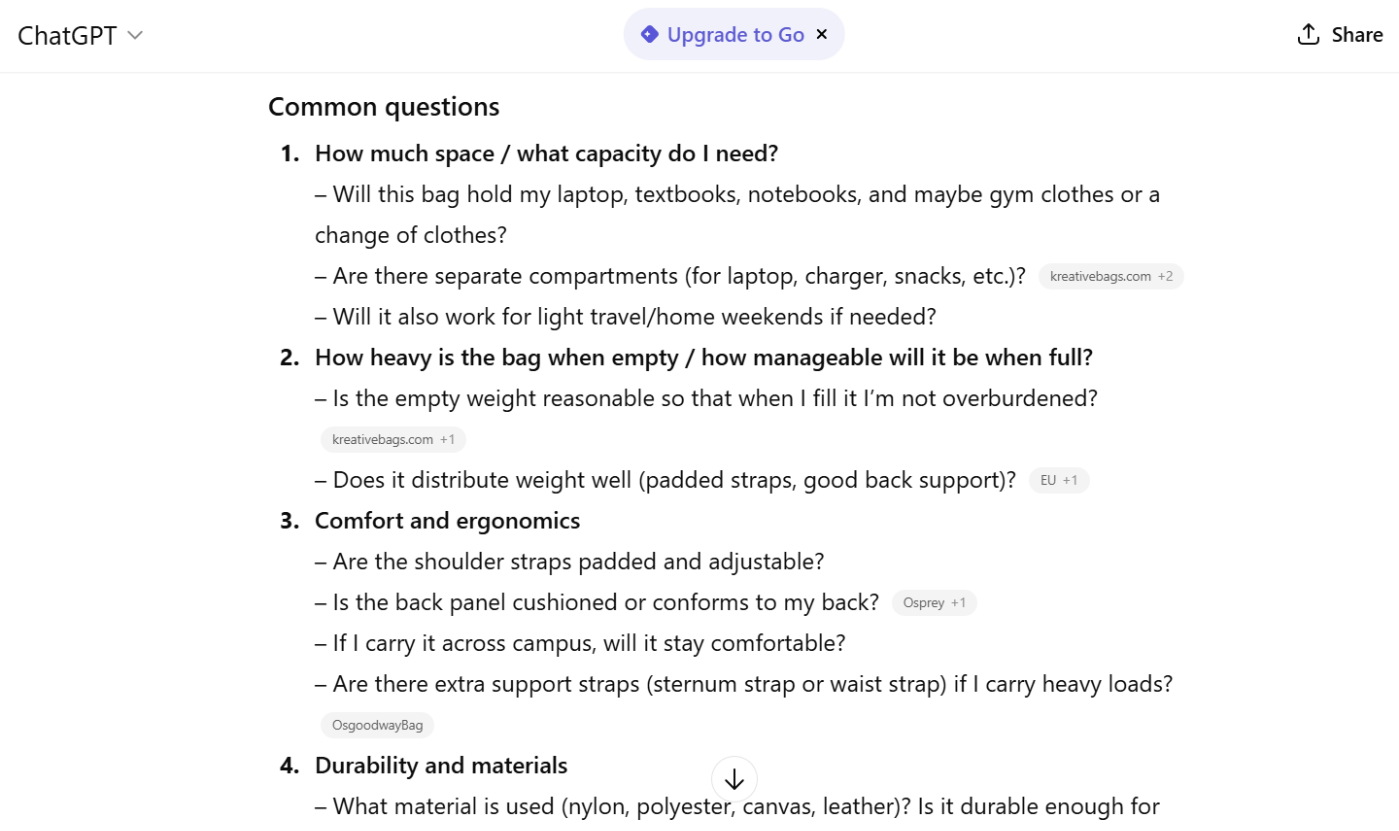
You can also use keyword tools like Ahrefs or Semrush and filter for phrases that are four to seven words long, with keyword difficulty under 30 and a decent Cost Per Click.
Then, ensure that your titles are benefit-driven. Don’t write “Guide to CRMs.” Instead, try “How to Pick the Right CRM Without Wasting Money on Features You Don’t Need.”
Finally, back your content with comparison tables, FAQ sections, and bullet points that focus on real outcomes. That’s what helps users make confident decisions, and that’s what converts.
11 Master Internal Linking for Authority Flow
Internal links indicate to Google which pages are most important on your site. They pass authority around, guide visitors through your content, and connect related topics so everything feels organized.
The problem is that most people treat internal linking as an afterthought, leaving a significant amount of SEO potential untouched.
Every time you publish a new post, make sure it links to 2 or 3 of your most important pages. Think of your main service pages, flagship products, or pillar content pieces.
Use descriptive anchor text, too. Instead of saying “click here” or “this post,” use something meaningful like “complete SEO audit checklist” or “WordPress speed optimization guide.” That gives both readers and search engines a clear context.

It also helps to add a “Related Articles” section at the end of every post. That small touch keeps people exploring your site instead of bouncing back to Google.

Another smart move is linking from your highest-traffic pages to your conversion pages. If you have a blog post that gets 10,000 visits a month but doesn’t link to your product or service page, you are missing out on potential customers.
For a full step-by-step breakdown on how to build a strong internal linking system, check out our tutorial.
12 Leverage User-Generated and Community-Driven Content
Google now prioritizes real human experience over polished corporate content. In fact, 82% of searches include at least one Reddit thread on the first page.
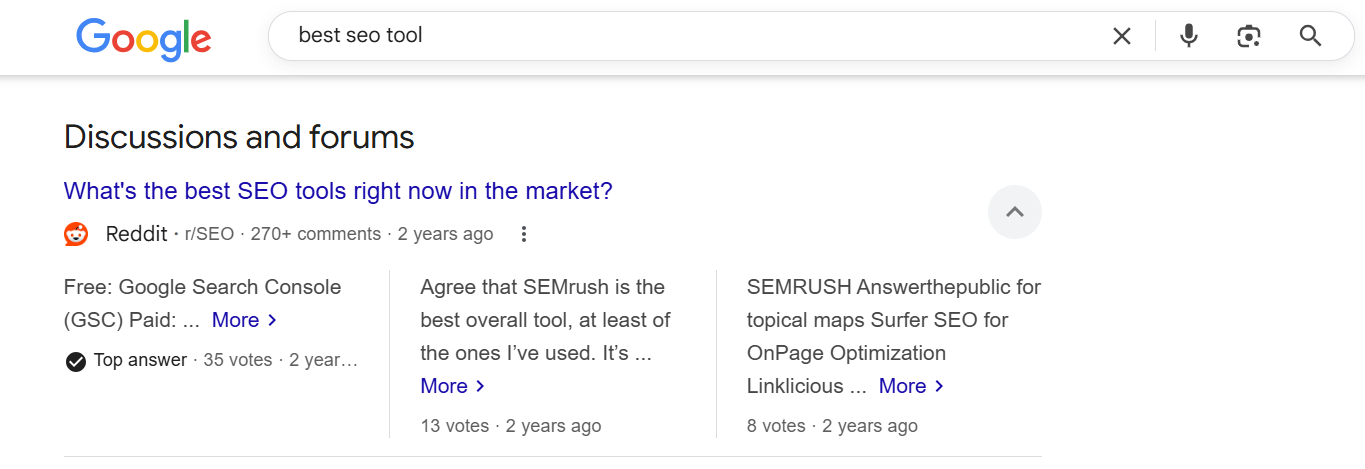
So instead of relying solely on the content you create yourself, start tapping into authentic community conversations.
Begin by encouraging reviews, Q&As, and discussions on your own site. Then optimize these pages to rank for terms like “[your product] reviews” or “[topic] discussions.”
Next, get involved in external communities like Reddit and Quora. Stick to the 80/20 rule: give 80% value through helpful answers before thinking about promoting your content. When you do share, frame it naturally as “Here’s how I solved this problem” rather than pushing a direct promotion.
Try finding three relevant Reddit threads and leave genuinely helpful, detailed answers without linking to your site. Focus on building credibility first.
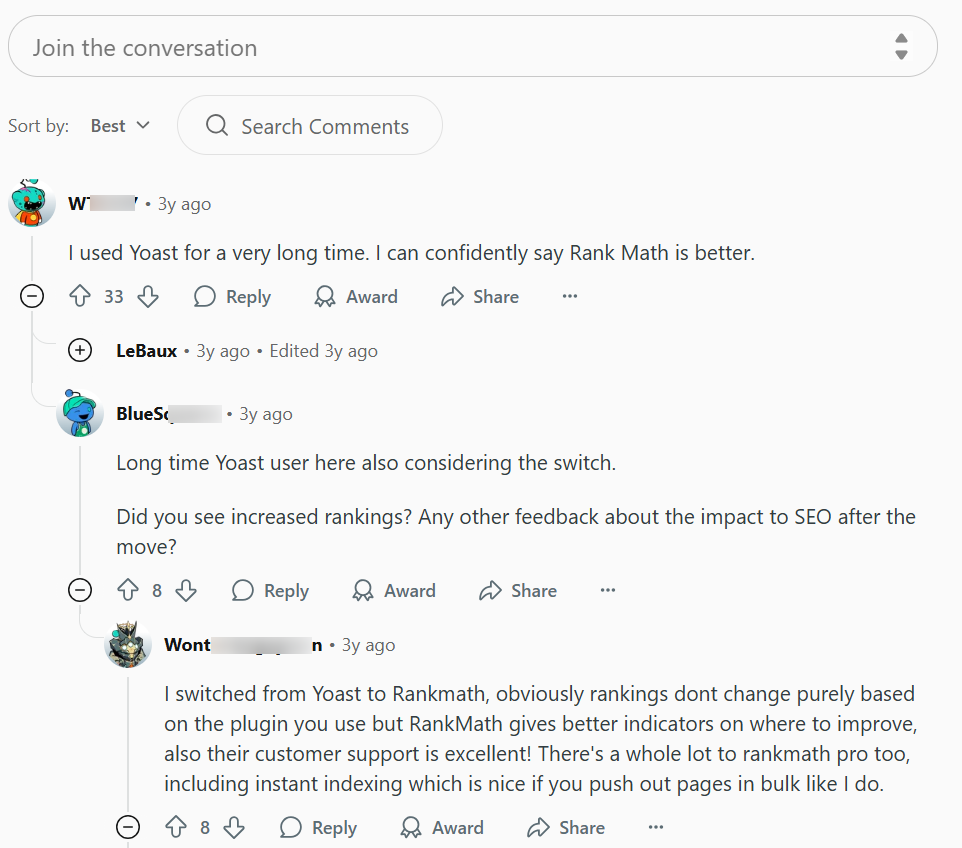
For a full guide on Reddit SEO, see our internal guide on dominating Reddit.
Finally, repurpose the content your community creates. Turn common questions into FAQs, blog posts, or videos. This way, you create a loop of real user feedback that both Google and your audience trust.
13 Build High-Quality Backlinks and Brand Signals
Backlinks and brand mentions are still two of the strongest signals Google uses to determine authority. But the game has completely changed from the guest-post-spam era.
Today, it’s less about how many links you have and more about the quality and credibility of where they come from.
Use tools like Ubersuggest’s free Backlink Checker or Ahrefs’ free Backlink Checker to see where your competitors are getting links from. Look for patterns. Target 10 to 15 high-value placements.
One link from a relevant, trusted site in your niche is worth more than 100 random directory links.
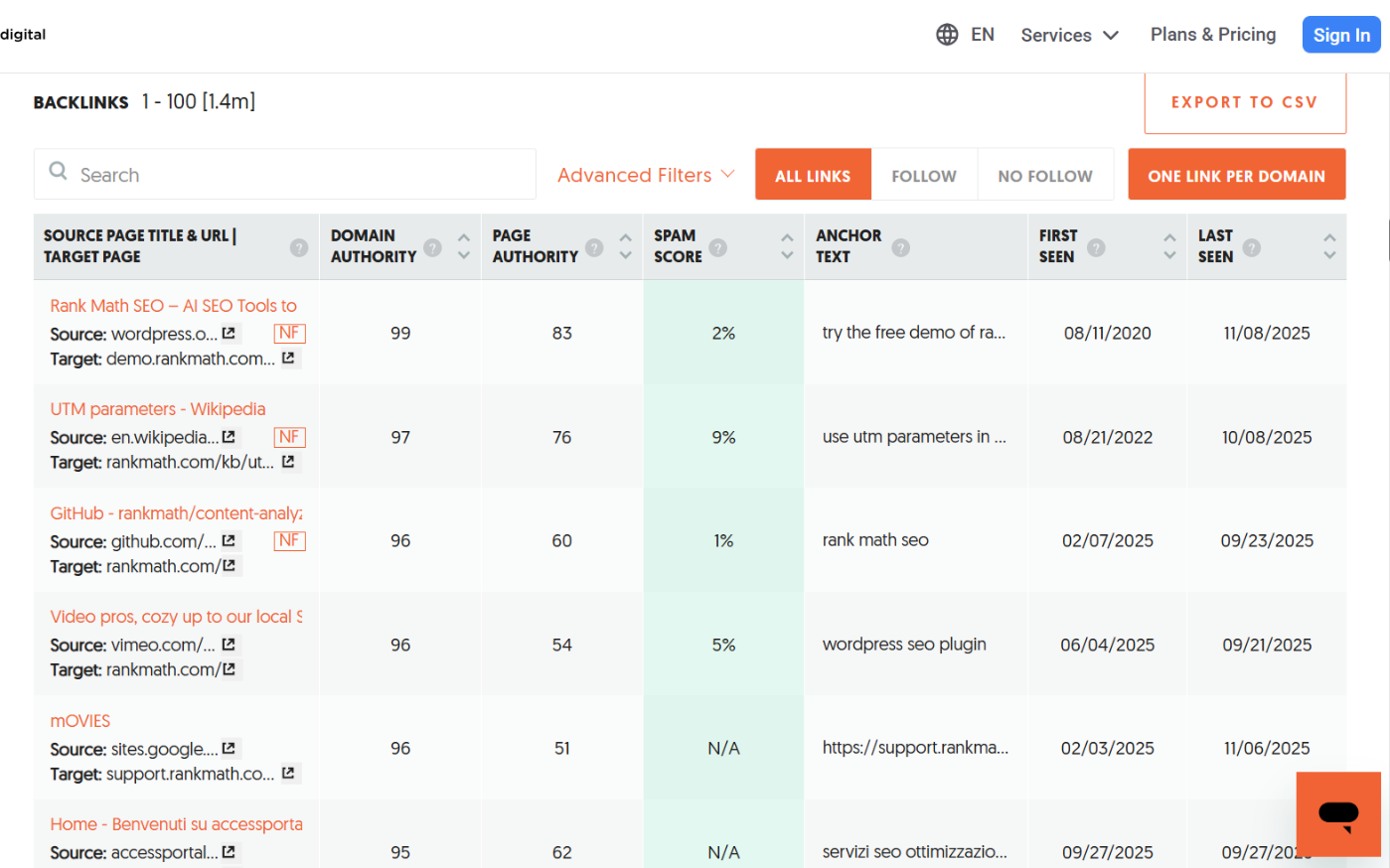
Create one original data asset this quarter. Run a small industry survey. Publish a case study with real numbers. Compile a mini-report with original research. Journalists and bloggers love citing fresh data.
Now here’s a tactic with crazy ROI: convert unlinked mentions to backlinks.
Set up Google Alerts or use Ahrefs to monitor your brand name. When someone mentions you without linking, reach out with a simple, friendly message.
That one action alone can bring in quick, high-quality backlinks.
14 Dominate Local Search (For Service Businesses)
If you’re running a local service business, Google Business Profile combined with local SEO can drive over 50% of your traffic.
Google rewards businesses that look busy, trusted, and relevant.
First, you need reviews. Lots of them. Aim for 150+. This isn’t just social proof; it’s a direct ranking factor. After you complete a job, send a simple text with a direct review link.
And when you get a review, respond within 24 hours. Every single one, good or bad.
Second, show Google you’re alive. Post on your Business Profile every week. Share a photo from a recent job. Announce a seasonal offer. Give a quick tip.
Third, your NAP (Name, Address, Phone) must be perfectly consistent everywhere online. On your website. On directory sites. On social media. Any inconsistency confuses Google.
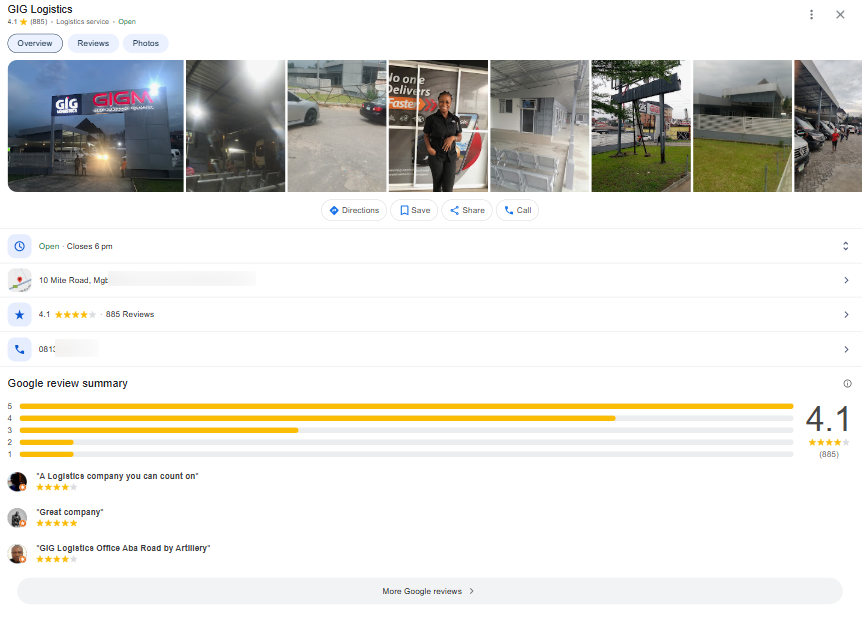
Create service pages for each location or zip code you serve. If you’re a plumber serving 5 neighborhoods, you need 5 optimized location pages. Add LocalBusiness Schema to each one.
You can use Rank Math SEO to optimize your multiple pages for local SEO and also help you add the LocalBusiness Schema to each page. Here’s a guide that can assist you.
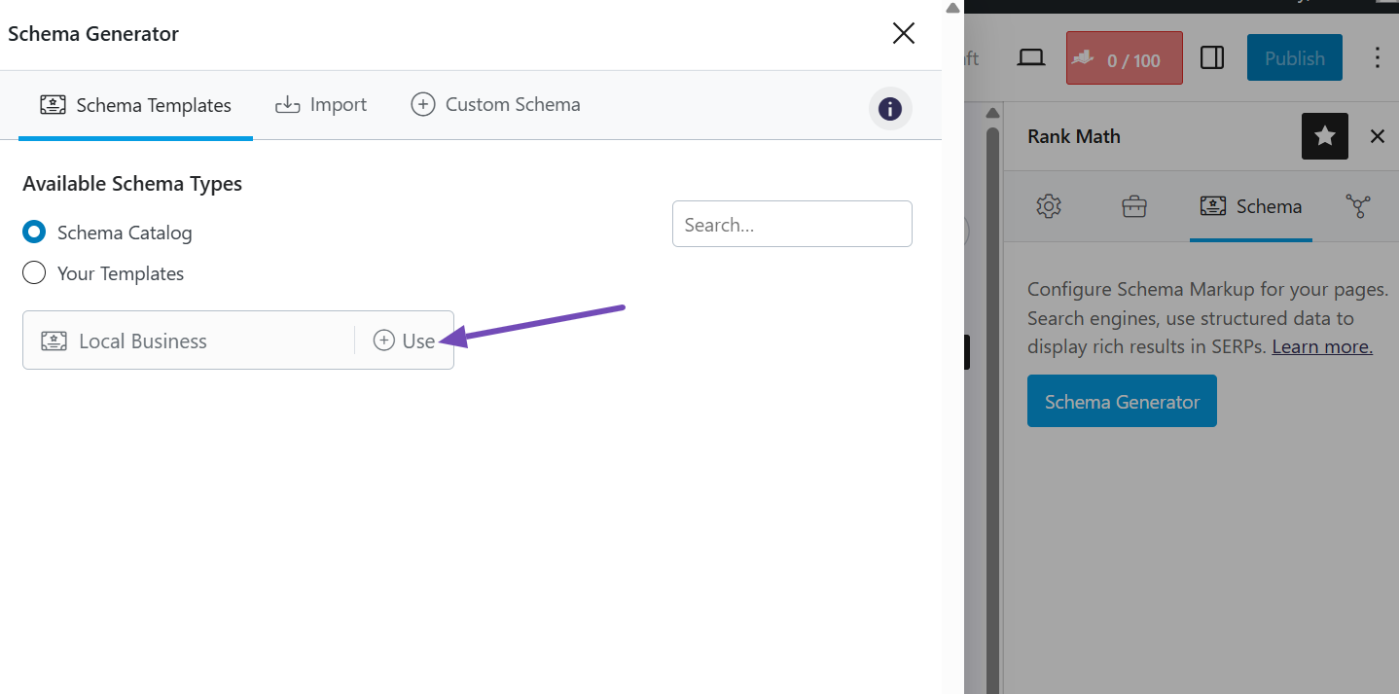
Then, build local citations. Get listed on Yelp, Yellow Pages, industry-specific directories, and your local chamber of commerce site.
15 Leverage High-DA Platforms for Quick Wins
Using high-authority platforms like Medium, LinkedIn Articles, Dev.to, or Hashnode can give your content instant visibility without waiting months for your own site to rank.
Think of it like borrowing someone else’s audience while you build yours.
So here’s what to do: take your best blog posts and repurpose them for these platforms. On Medium, tag them correctly (you get 5 tags, use all 5 strategically). On LinkedIn, add hashtags that your target audience actually follows.
Always include a link back to your site in your author bio or naturally within the content when it makes sense.
Post consistently. Once or twice a week is the sweet spot. And engage with comments. When someone replies to your post, respond thoughtfully.
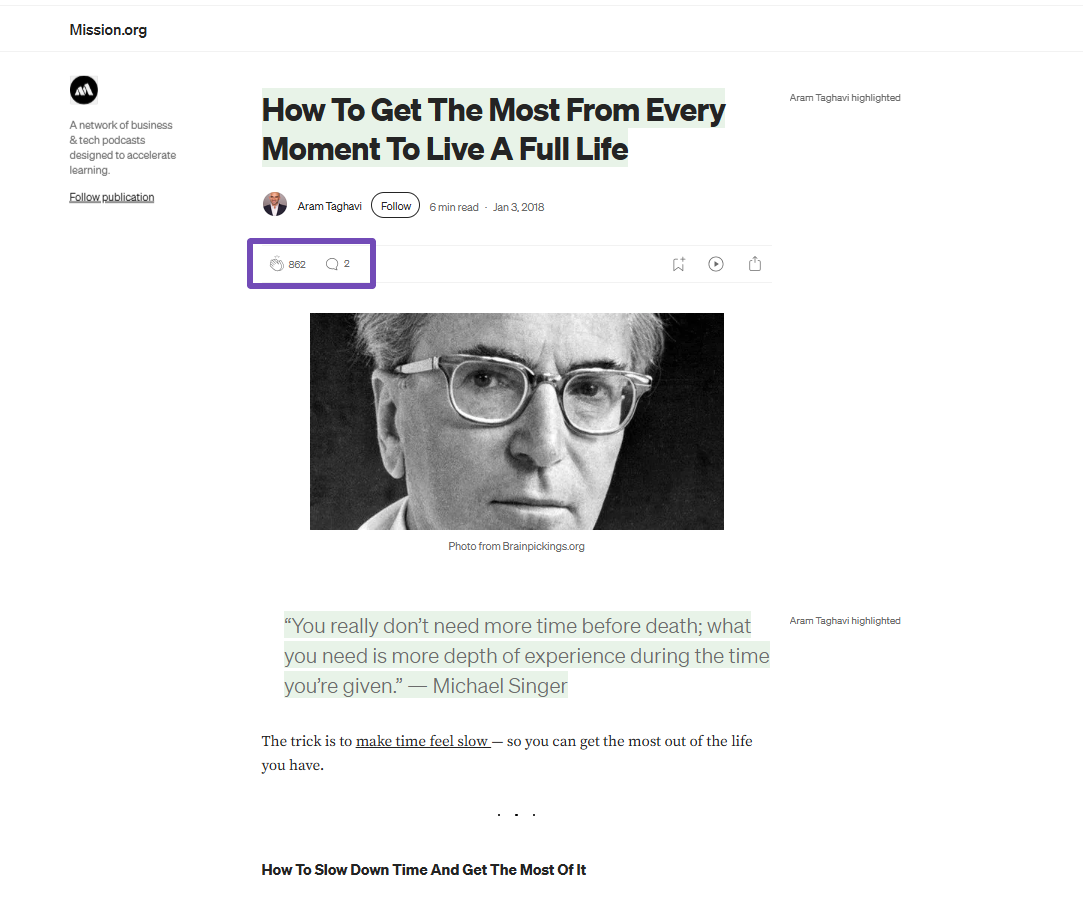
Your own domain might take 6 months to rank. A well-optimized Medium post can rank in weeks because you’re riding Medium’s domain authority.
16 Create Funnel-Driven Content That Converts
I need to be straight with you. Driving traffic is only half the job. If your site doesn’t convert that traffic and improve your conversion rates, you’re just spinning your wheels. Let’s talk about fixing the leak in your bucket.
First, you have to attract the right people. Stop creating content for everyone and start creating for potential customers. The person searching “what is a CRM” is just curious. The one searching “best CRM for real estate teams under $100” has their credit card out. See the difference?
Your most powerful content targets that second person. Create honest “X vs. Y” comparison guides. Write “Why We Built This Differently” posts that speak to specific frustrations. This content resonates with people who are ready to make a purchase, not just browse.
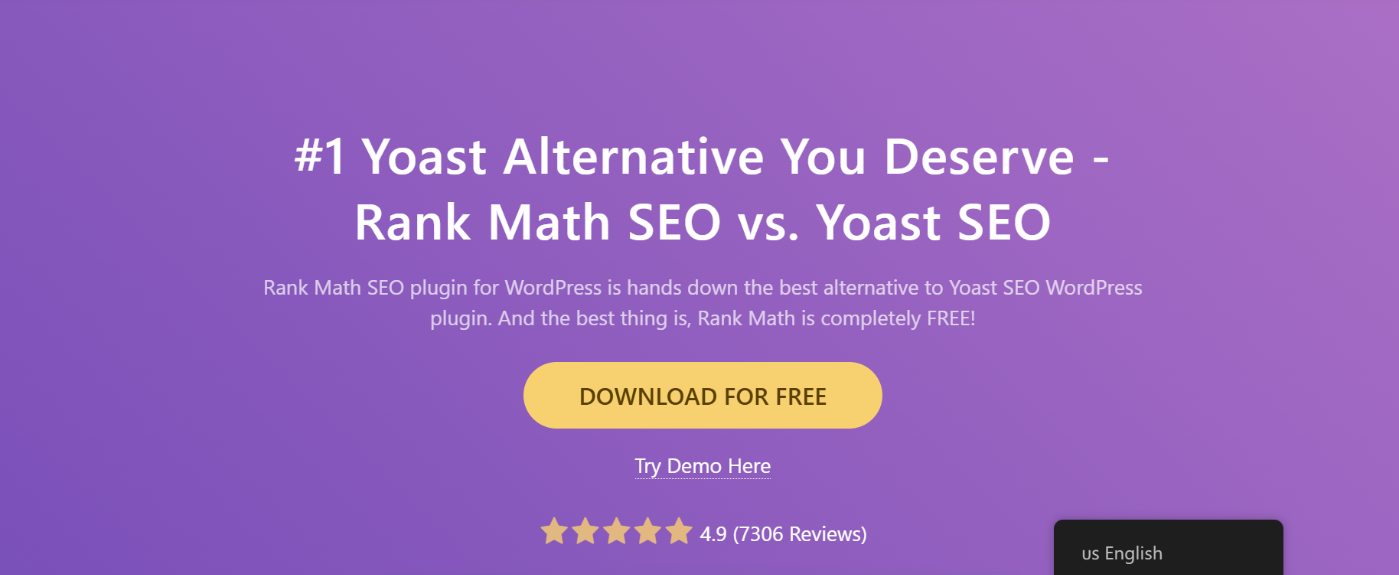
But getting them to your site is only the start. Now you have to persuade them.
Look at your landing page. Is your call-to-action button a boring “Submit” or “Learn More”? Change it to “Get My Free Template” or “Start My Trial.” Tell them what they get.
And please, add social proof right at the top. A short, powerful testimonial next to your sign-up form can be the final nudge someone needs.
Here is a simple thing you can do this week. Pick one of your blog posts that gets traffic but no conversions.
Maybe it’s a general “how-to” guide. Update the title to target a buyer. Change “Guide to Project Management” to “How to Choose the Right Project Management Software.”
Then, add a clear, benefit-driven CTA in the conclusion, offering a related checklist or demo.
This one-two punch, attracting buyers and then convincing them to act, is how you turn your SEO strategy efforts into a real business engine.
17 Create Video-First Content and Repurpose Across Platforms
People are consuming more video than ever, and search engines know it. YouTube gets over 3 billion searches monthly, making it the second-largest search engine after Google.
About 80% of Google searches now include a video snippet, and 22% show at least one YouTube video on page one.
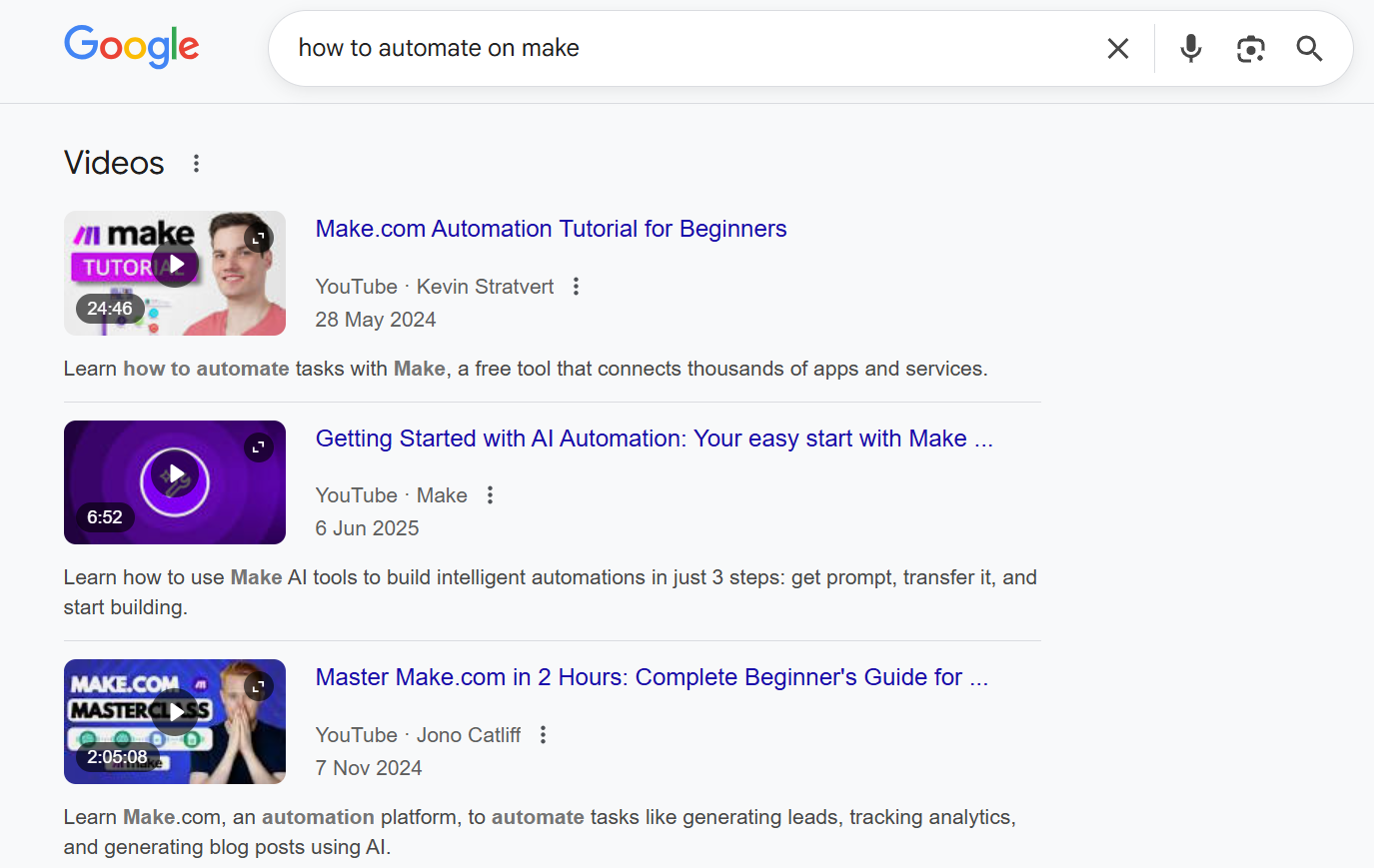
Here’s what to do:
- Record a 3 to 5 minute video for every major blog post. It doesn’t need to be fancy. Use your phone. Share your screen. Just explain the concept naturally.
- Upload it to YouTube. Put your target keyword in the title. Write a 250-word description with timestamps for different sections.
- Embed the video at the top of your blog post. This immediately increases dwell time. Most people will watch at least part of the video before they scroll.
- Repurpose into Shorts, Reels, and TikToks. Keep each under 60 seconds. Hook attention in the first 3 seconds.
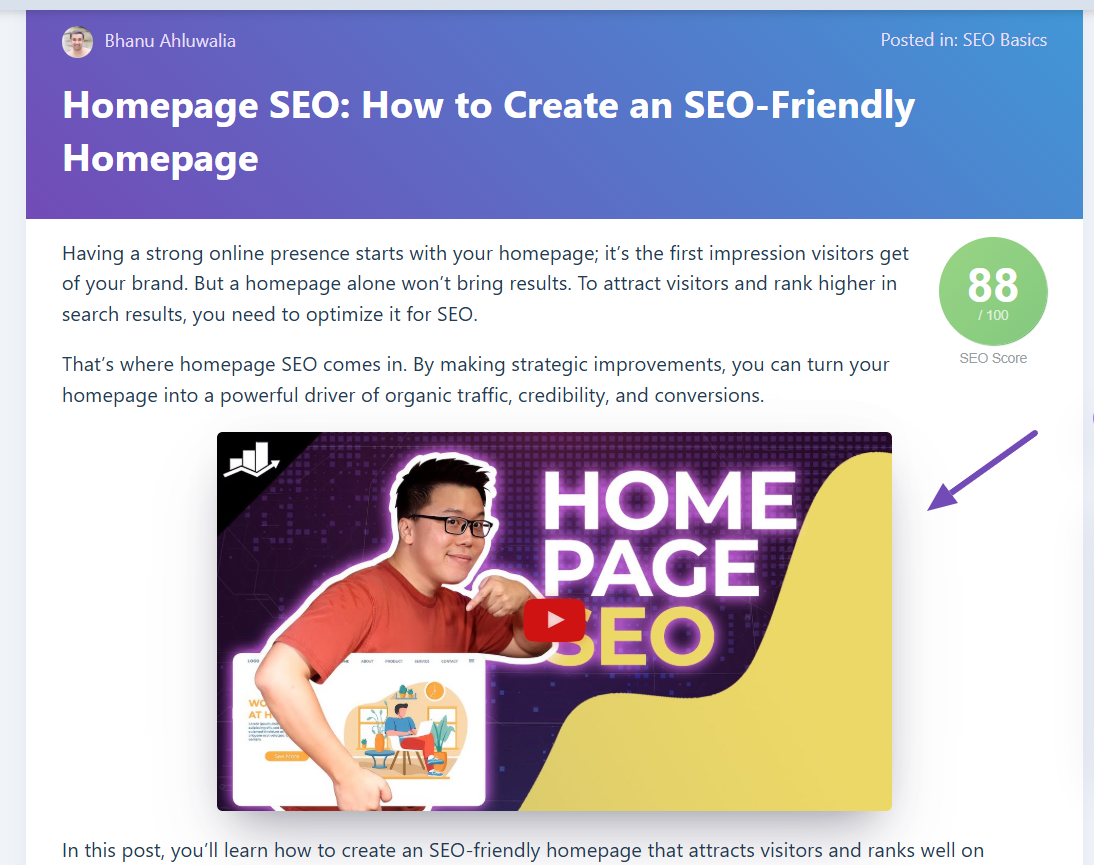
Post consistently. Three to five times per week across your main platforms.
One video can do multiple jobs. It boosts your blog post rankings through engagement. It ranks independently on YouTube and Google. It reaches people on social platforms who would never read a blog post.
18 Build Brand Presence Across Channels
Let me ask you a question. When was the last time you blindly bought from a brand you’d never heard of? Probably never. That’s the power of brand.
Approximately 33% of Google searches are branded, and 97% of people research a company online before doing business. Brand building is not just about PR; it’s also an SEO move that increases organic traffic.
If no one is searching for your brand, you are missing a huge part of the organic traffic opportunity. SEO today is not only about ranking for generic keywords. It is about making your brand visible and trusted enough to become the keyword.
So how do you build that? Show up consistently where your customers spend time. Not by spamming links, but by offering real value through social media and content.
Be a helpful voice. Join relevant LinkedIn conversations and Reddit threads and give genuine answers. When you help without expecting anything in return, people remember your name.
Create a signature framework that people can link to your brand. Do not just share generic tips. Develop a simple method or system that your audience can refer to.
Finally, consider appearing on niche podcasts or writing guest posts. It introduces you to a whole audience that already trusts the host. You gain recognition that later turns into branded searches and stronger organic growth.
19 Use Programmatic SEO to Scale Smartly
If you’ve ever wondered how some sites suddenly appear for hundreds of long-tail keywords, that’s usually programmatic SEO at work. It’s a smart way to scale content using templates and data, not shortcuts.
Think of it this way. Instead of manually writing a thousand pages about “best coffee shops in [City],” you create one smart template. You then pull from a database of cities, neighborhoods, and coffee shop details to automatically generate a unique, helpful page for each location.
This is how companies like Zapier or TripAdvisor dominate search results for millions of local queries. They aren’t manually writing each page; they’re building a system that does it for them.
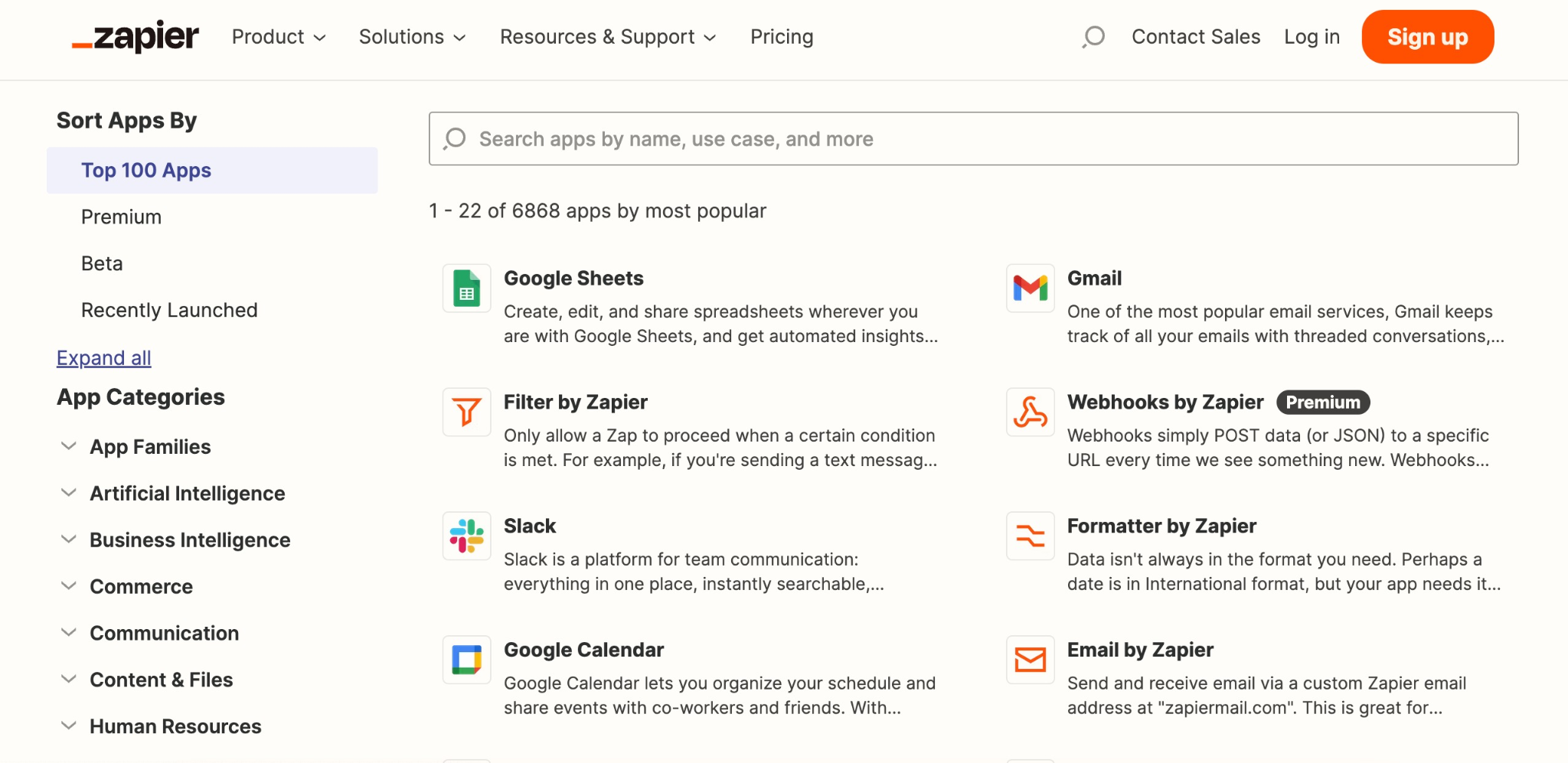
But here’s the catch: this is advanced. Google is very good at spotting low-quality, auto-generated pages. If you do this wrong, you can seriously hurt your site.
Here’s how to approach it safely and effectively:
- Start small. Test with approximately 100 pages before scaling up.
- Create a clean template that incorporates unique text blocks, dynamic data, and a user-friendly layout. Each page should have at least 500 words of genuine, high-quality content.
- Make sure at least 30 to 40% of each page is unique. Google’s getting smarter at detecting copy-paste automation.
- Roll out gradually, maybe 1,000 pages at a time, and track indexing, impressions, and engagement in Google Search Console.
Don’t fall into the trap of flooding Google with thousands of pages overnight; it’ll likely backfire. Quality control is everything here.
Use “hub” pages to connect related programmatic pages and strengthen structure through content optimization.
If you do it right, you’ll start seeing steady results in about 3 to 6 months.
For more details, refer to our guide on programmatic SEO.
20 Track Metrics That Actually Matter and Adapt
Most people track the wrong metrics, celebrating traffic spikes from viral posts that yield zero sales or panicking over a keyword ranking drop that doesn’t impact revenue. Stop focusing on vanity metrics and track what drives your business forward.
Forget “traffic.” Track qualified organic traffic. Are they the right audience? Monitor conversion rates by landing page and customer lifetime value using Google Analytics. These metrics reveal if your SEO efforts are effective.
Stay alert to changing search results. Google’s algorithm evolves constantly. Check the top 20 searches for core pages weekly. Look for shifts in rankings:
If you lose a featured snippet, audit the winner. Improve clarity, structure, and intent to reclaim it.
If AI Overviews steal clicks, add a “TL;DR” answer box and pair it with gated resources, such as checklists or templates, to drive clicks.
If a Reddit thread outranks you, Google values authentic discussions. Build a Reddit presence or add real-user case studies to your content.
Conclusion
The sites winning in 2025 succeed because they focus on the right actions. They provide real value, keep content updated, engage visitors, and stay active across key platforms.
Strong engagement signals indicate to Google that your content is effective. Useful visuals, videos, and tools help keep people on your pages.
Prioritize the right audience. Create solutions, use clear calls to action, and measure what truly drives results.
Do not attempt to use all 20 strategies simultaneously. Choose 3, commit for 90 days, track progress, and double down on what works.
With steady effort, you build authority, improve engagement, and grow organic traffic.
The opportunity is real for those who adapt. Focus on helping people, earning trust, and staying flexible. That is how you win.
If you like this post, let us know by Tweeting @rankmathseo.
